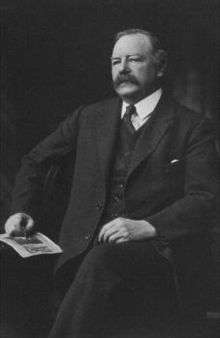Arthur Pillans Laurie
Prof Arthur Pillans Laurie FRSE LLD (1861 – 1949) was a Scottish chemist who pioneered the scientific analysis of paintings.
Arthur Pillans Laurie | |
|---|---|
 | |
| Born | 6 November 1861 |
| Died | 1949 |
| Nationality | Scottish |
| Alma mater | Cambridge University |
| Known for | Infrared photography of paintings |
| Scientific career | |
| Fields | Chemistry, Analysis of paintings |
| Institutions | Royal College of Arts |
| Influences | William Holman Hunt |
Biography
Laurie was born on 6 November 1861, the son of Simon Somerville Laurie FRSE and his wife, Catherine Ann Hibburd.[1] The family lived at Brunstane House, an impressive 17th century country house, south of Portobello in eastern Edinburgh.[2]
He was educated at Edinburgh Academy from 1871 to 1878, then studied Science at University of Edinburgh and then King's College, Cambridge, where he took a first in science in 1884.[3]
The pre-Raphaelite painter William Holman Hunt interested Laurie in the chemistry of paint and the scientific analysis of paintings. Laurie pioneered the use of chemical analysis to discover the composition of artworks, and so to show their true age and origins. He was the first to use infrared photography to reveal deeper layers of paint. Through infrared work, he found the date of a Rembrandt self-portrait where the date painted by the artist had later been covered up.[3]
In 1885 Laurie was elected a Fellow of the Royal Society of Edinburgh. Hios proposers were Peter Guthrie Tait, Alexander Crum Brown, Edward Sang and George Chrystal.[4]
In 1895 Laurie became a lecturer at St Mary's Hospital Medical School, and joined the Royal Commission on Secondary Education.[3]
In 1898 the Royal College of Physicians made him an examiner in chemistry.[3]
In 1900, Laurie became the principal of Heriot-Watt College, Edinburgh. He held this position until 1928.[3]
In 1912 Laurie became the professor of chemistry to the Royal Academy of Arts.[3]
In the First World War Laurie did extensive, if perhaps controversial, work as Chairman of the Chemical Inventing Committee, part of the Munitions Inventions Department, and also served on the Chemical Waste Products and Buildings Committee.[5]
In 1929 he stood as a candidate for parliament at the General Election in the constituency of Edinburgh South for the Liberal party, finishing second.
In 1939 Laurie wrote the notorious The Case for Germany, (1939), a pro-Nazi work which praises Hitler's Germany. The book commences with praising Hitler as a painter and then expounds National Socialism. He continues with a defence of Nazism as he experienced it during his stay in Germany and criticizes Marxist socialism. Laurie, however, was not antisemitic and defends the Jewish people on multiple occasions throughout his book, for example: "We find the Jew a law-abiding, hard-working citizen, and have no complaint to make."[6]
He died on 7 October 1949.
Publications
Among Laurie's many technical writings are the following.[3]
- The Food of Plants, (1893)
- Facts About Processes, Pigments, and Vehicles - a Manual for Art Students, (1895)
- Greek and Roman Methods of Painting, (1910)
- The Materials of the Painter's Craft in Europe and Egypt, from the Earliest Times to the End of the XVIIth Century, (1910)
- The Pigments and Mediums of the Old Masters, (1914)
- The Painter's Methods and Materials, (1926)
- A Study of Rembrandt and the Painting of his School, (1929)
- The Brush Work of Rembrandt and his School, (1932)
- Pictures and Politics, (1934)
- New Light on Old Masters, (1935)
- The Case for Germany, (1939)
Family
His father was the educator Simon Somerville Laurie. He was the brother of zoologist Malcolm Laurie (1866-1932), both of whom were also fellows of the RSE.[4]
References
- Biographical Index of Former Fellows of the Royal Society of Edinburgh 1783–2002 (PDF). The Royal Society of Edinburgh. July 2006. ISBN 0-902-198-84-X. Archived from the original (PDF) on 4 March 2016. Retrieved 17 March 2017.
- Edinburgh and Leith Post Office directory 1870-71
- "Arthur Pillans Laurie". Biographical Information. NAHSTE (Navigational Aids for the History of Science, Technology & the Environment). Archived from the original on 14 July 2012. Retrieved 9 October 2012.
- "Former Fellows of the Royal Society of Edinburgh 1783-2002" (PDF). Biographical Index, Part Two. Royal Society of Edinburgh. July 2006. Archived from the original (PDF) on 16 January 2014. Retrieved 8 October 2012.
- Biographical Index of Former Fellows of the Royal Society of Edinburgh 1783–2002 (PDF). The Royal Society of Edinburgh. July 2006. ISBN 0-902-198-84-X. Archived from the original (PDF) on 4 March 2016. Retrieved 17 March 2017.
- Laurie, Arthur Pillans (1939). The Case for Germany (Second ed.). Chapter 3: "National Socialism": Internationaler Verlag.CS1 maint: location (link)
Bibliography
- Year Book of the Royal Society of Edinburgh 1950 (Session 1948-1949), Oliver and Boyd, Edinburgh, 1951.
- Who's Who 1938, A&C Black, London, 1937.
- Rawlins, FIG; Hartley, Harold; Farmer, RC; Stacey, M. (1950). "Obituary notices: Arthur Pillans Laurie, 1861–1949; Sir Henry Miers, 1858–1942; Sir Robert Robertson, 1869–1949; F. E. Whitmore, 1923–1949". Journal of the Chemical Society: 429–441. doi:10.1039/JR9500000429.